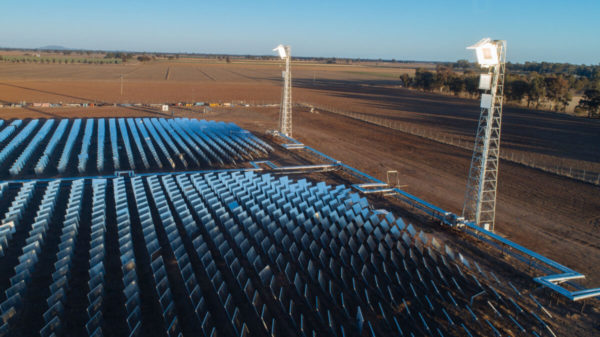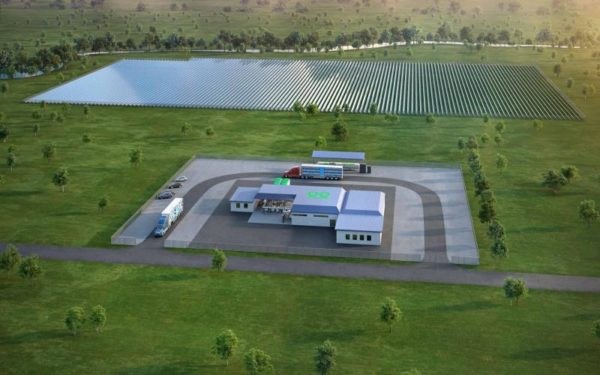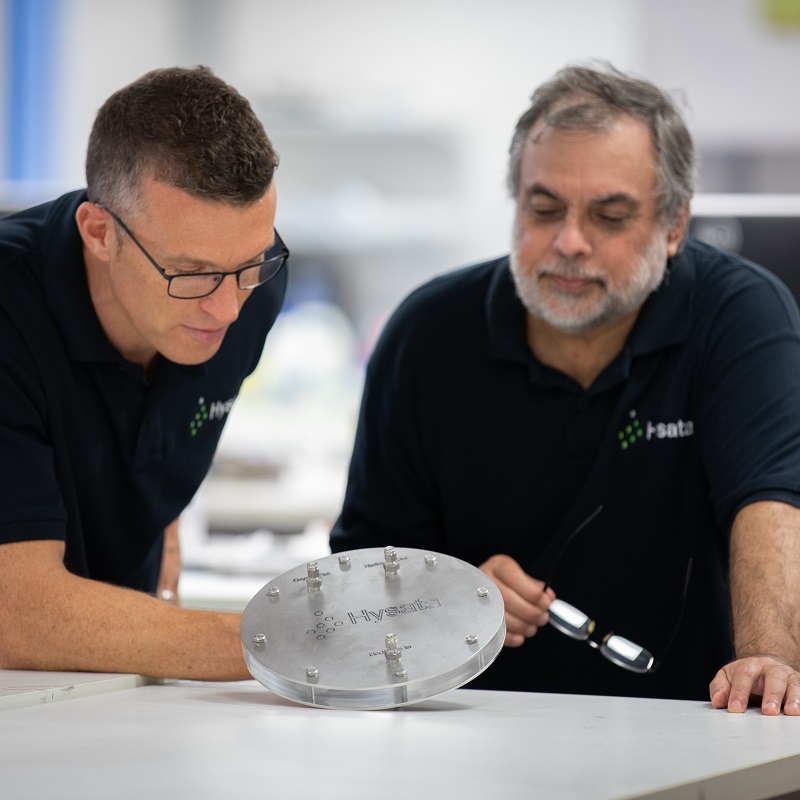Australian hydrogen electrolyser technology firm Hysata has been selected as one of the successful grant recipients for the German-Australian Hydrogen Innovation and Technology Incubator (HyGATE), a joint initiative focused on establishing a green hydrogen supply chain between the two countries.
The Australian and German governments have announced conditional funding of up to $50 million (USD 35.5 million) and EUD 40 million ($61.2 million, USD 43.5 million), respectively, has been awarded across four projects as part of the HyGATE initiative that aims to spark collaboration between industry and research partners for the development of renewable hydrogen technologies and open up new market opportunities.
Hysata is among those to receive funding as part of the initiative, awarded $8.98 million from the Australian Energy Agency (ARENA) and $9 million (EUD 5.9 million) from Germany’s Federal Ministry of Education and Research (BMBF) to support the development of the company’s electrolyser technology which it said will deliver the most efficient electrolyser in the world.
Based in the Illawarra on the New South Wales (NSW) south coast, Hysata will work with Germany’s Fraunhofer Institute for Production Technology to develop its ‘capillary-fed’ electrolyser technology to deliver low-cost hydrogen at Port Kembla.
Hysata Chief Executive Officer Paul Barrett said the company’s electrolyser technology operates at 95% system efficiency, delivering a “giant leap” in performance and cost over incumbent technologies, which he said typically operate at 75% or less.
Barrett said Hysata’s electrolysis cell can produce green hydrogen from water at 98% cell energy efficiency.
The company says its technology could enable hydrogen production of below $1.50 per kg by the “mid 2020s”, making hydrogen commercially available and supports Australia’s ambitions of reducing the cost of green hydrogen to facilitate its wider adoption.
“Australia has a once-in-a-generation opportunity to be a global leader in green hydrogen and we are delighted to see the government backing Australian innovators,” Barrett said.
“Our technology will enhance sovereign manufacturing capabilities, create high-skilled jobs and position Australia as a green hydrogen powerhouse by providing electrolysers for domestic projects and exports.”
Hysata said the technology has been proven at lab-scale and the company is now focused on developing and commercialising a full-scale system with Barrett saying the funding will allow Hysata to tap into German engineering expertise to help it design its “factory of the future.”

Image: Vast Solar
The other projects to receive funding under the Hygate initiative include a“world-first” green methanol production plant proposed by Australian concentrated solar thermal power (CSP) specialist Vast Solar and German engineering consultancy Fichtner and a green hydrogen project backed by Australian renewables developer Edify Energy and German engineering and technology company Siemens Energy. The Australian arm of Canadian gas giant ATCO will also receive funding for a green hydrogen and ammonia production facility in New South Wales (NSW).
Vast Solar and Fichtner, part of the broader Solar Methanol Consortium, will receive almost $40 million ($19.48 million and EUR 13.2 million) to develop a “world-first” green methanol production plant near Port Augusta in South Australia.
The SM1 project entails the use of a 10 MW electrolyser for the manufacture of green hydrogen as an input to green methanol production. The project is to be powered by a 30 MW CSP plant Vast Solar is developing at Port Augusta.
Vast Solar Chief Executive Officer Craig Wood said SM1 will produce 7,500 tonnes of green methanol per annum and has already attracted the interest of local and international offtakers, including major shipping companies and airlines.
“SM1 has the potential to supply the shipping and aviation industries with zero-emission fuel,” he said. “This is a major step forward in helping to decarbonise hard-to-abate sectors. Today’s announcement has the potential to supercharge the domestic renewables industry.”

Image: Edify Energy
The Edify project, known as EGH2, is the first stage of a planned 1 GW green hydrogen production facility that will export hydrogen globally through the Port of Townsville in north Queensland.
The first phase of the project includes the deployment of a 17.5 MW Siemens Energy electrolyser, which will be powered by 21 MW of solar, to produce green hydrogen. The aim is to expand the project to an electrolyser capacity of 1 GW capable of producing up to 150,000 tonnes of green hydrogen a year.
Edify has been awarded more than $45 million ($20.74 million and EUD 16.4 million) to progress the project.
The Sydney-headquartered company is also in the development stages of building its 200 MW Majors Creek Solar Power Station, which will supply electricity to the Lansdown facility.
ATCO was awarded almost $8 million ($800,000 and EUD 4.7 million) to investigate the feasibility of developing a 1 GW green hydrogen production facility and 800,000 tonne per year green ammonia facility near Port Kembla in NSW.
Karen Nielsen, managing director of Global Renewables at ATCO, said the output of both facilities, known collectively as ScaleH2, is be exported to Germany, creating a scalable export value chain.
“ATCO has set its sights on exports to global markets and the ScaleH2 project will further advance our ambitions to expand our capabilities as a hydrogen leader in Australia and the globe,” she said. “The ScaleH2 project, with our partners, will accelerate understanding across industry of hydrogen’s economic potential towards a clean energy future.”
Delighted to join with the German Minister @starkwatzinger to announce joint 🇦🇺🇩🇪 funding of green hydrogen projects in the Illawarra, Townsville & Port Augusta
🇩🇪is keen to become a major consumer of 🇦🇺green hydrogen. Our partnership will unlock jobs & clean energy pic.twitter.com/5uLkH82XuF
— Chris Bowen (@Bowenchris) January 27, 2023
As well as the funding announcement, Australian Energy Minister Chris Bowen and Germany’s Minister of Education and Research Bettina Stark-Watzinger released a joint report which outlines the steps needed to establish a supply chain for renewable hydrogen between our countries.
Bowen said the collaboration with Germany further helps Australia strengthen its renewable energies export infrastructure, while allowing Germany to meet its growing energy needs via cleaner sources.
“Collaboration with Germany will help grow Australia’s hydrogen export market and support our nation’s vision of becoming a renewable energy superpower,” he said.
Bowen said by 2050, Australia’s hydrogen industry could generate $50 billion in additional GDP and create more than 16,000 jobs, as well as an additional 13,000 jobs from the construction of renewable energy infrastructure to power the production of green hydrogen.
This content is protected by copyright and may not be reused. If you want to cooperate with us and would like to reuse some of our content, please contact: editors@pv-magazine.com.









1 comment
By submitting this form you agree to pv magazine using your data for the purposes of publishing your comment.
Your personal data will only be disclosed or otherwise transmitted to third parties for the purposes of spam filtering or if this is necessary for technical maintenance of the website. Any other transfer to third parties will not take place unless this is justified on the basis of applicable data protection regulations or if pv magazine is legally obliged to do so.
You may revoke this consent at any time with effect for the future, in which case your personal data will be deleted immediately. Otherwise, your data will be deleted if pv magazine has processed your request or the purpose of data storage is fulfilled.
Further information on data privacy can be found in our Data Protection Policy.